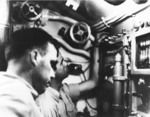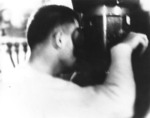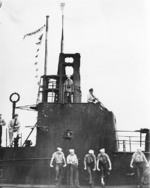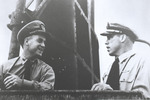Richard O'Kane
| Surname | O'Kane |
| Given Name | Richard |
| Born | 2 Feb 1911 |
| Died | 16 Feb 1994 |
| Country | United States |
| Category | Military-Sea |
| Gender | Male |
Contributor: C. Peter Chen
ww2dbaseRichard Hetherington "Dick" O'Kane was born in Dover, New Hampshire, United States in 1911. He graduated from the United States Naval Academy in May 1934 and served with cruiser USS Chester and destroyer USS Pruitt. In 1938, he was trained as a submariner, and was assigned to submarine USS Argonaut, aboard which he served until early 1942 when he was transferred to the soon-to-be commissioned new submarine USS Wahoo. As the executive officer, O'Kane served aboard Wahoo under Lieutenant Commander Marvin Kennedy and Lieutenant Commander Dudley Morton for Wahoo's first five war patrols. Morton's trust and reliance on him gave O'Kane the confidence and ability to succeed in his later posts. Under Morton, in a reversal of standard practice, he was the one who manned the periscopes while Morton personally performed the target analysis.
ww2dbaseIn Jul 1943, O'Kane was transferred away from USS Wahoo in preparation of his new assignment as the commanding officer of the soon-to-be commissioned submarine USS Tang; he was officially commissioned as the commanding officer on 15 Oct 1943. He was known to be an aggressive commander who took calculated risks in order to fulfill his duties as a submarine commander, especially as he believed that the submarine was meant to be a purely offensive vessel. In five war patrols under his command, USS Tang sank 31 ships totaling 227,000 tons, making Tang one of the most successful submarines in WW2. In the early hours of 25 Oct 1944, immediately after a wildly successful series of attacks in Taiwan Strait off Niushandao, Fujian, China, USS Tang was hit by her own torpedo that circled back. He survived the submarine's sinking and was captured by the Japanese. Since the Japanese regarded American submarine attacks on Japanese civilian ships a war crime, he and the eight fellow survivors of USS Tang were held as special prisoners at Ofuna prison camp near Yokosuka, Japan, which made them even more vulnerable to violent abuses than typical prisoners of war. All nine survived the war, and O'Kane was awarded the Medal of Honor for his success in the final war patrol. His Medal of Honor Citation read:
ww2dbaseAfter the war, O'Kane remained in the US Navy, serving as the commanding officer of submarine tender USS Pelias in the Pacific Reserve Fleet; during this time, he also testified during the Tokyo war crimes trials. He later served as the executive officer of submarine tender USS Nereus, followed by a period as the commanding officer of Submarine Division 32. Between 1950 and 1951, he studied at the Armed Forces Staff College. Between 1951 and 1953, he was assigned to the Submarine School at New London, Connecticut, United States; during the final year in that period he was the Officer in Charge. In Jul 1953, he was promoted to the rank of captain and was commissioned the commanding officer of submarine tender USS Sperry. In Jun 1954, he became the commanding officer of Submarine Squadron 7. Between 1955 and 1956, he studied at the Naval War College. In 1956, he served with the Ship Characteristics Board in Washington DC, United States until his retirement in Jul 1957. He was promoted to the rank of rear admiral on the Retired List. He wrote the book Clear the Bridge!: The War Patrols of the USS Tang in 1977 and Wahoo: The Patrols of America's Most Famous World War II Submarine in 1987. He passed away in Petaluma, California, United States two weeks after his 83rd birthday, and was buried in Grave 874 in Section 59 of the Arlington National Cemetery, Virginia, United States.
ww2dbaseSources:
Alex Kershaw, Escape from the Deep
Wikipedia.
Last Major Revision: Jan 2011
Richard O'Kane Interactive Map
Photographs
 |  |  |  |
Richard O'Kane Timeline
| 24 Mar 1944 | Submarines USS Tang, Sealion (Balao-class) and Tinosa rendezvoused south of Danjo Gunto and began operating as a wolfpack in the shipping lanes off Nagasaki in southern Japan. |
Você gostou deste artigo ou achou este artigo útil? Se sim, considere nos apoiar no Patreon. Mesmo USD $1 por mês já vai longe! Obrigado. Por favor, ajude-nos a espalhar a palavra: Fique atualizado com WW2DB: |
» Argonaut (Argonaut-class)
» Tang
» Wahoo
- » 1,167 biographies
- » 337 events
- » 44,606 timeline entries
- » 1,243 ships
- » 350 aircraft models
- » 207 vehicle models
- » 376 weapon models
- » 123 historical documents
- » 261 facilities
- » 470 book reviews
- » 28,500 photos
- » 365 maps
James Forrestal, Secretary of the Navy, 23 Feb 1945
Por favor, considere nos apoiar no Patreon. Mesmo R$1 por mês já faz uma grande diferença. Obrigado!
Ou, por favor, nos apoie adquirindo alguns produtos do WW2DB na TeeSpring. Obrigado!